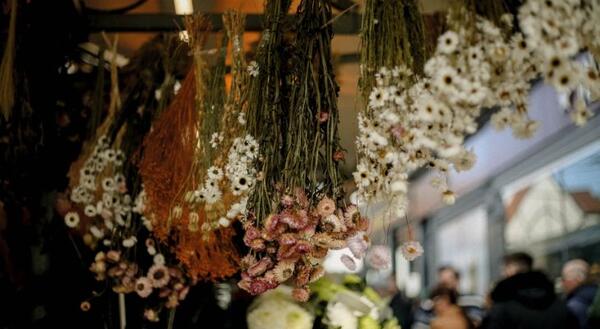
Your garden's floral showcase may be ending but the flowers need not disappear. Extend the life of floral garden favorites by preserving them for indoor decor. The art of preserving flowers and plant materials has been practiced for hundreds of years; colonial Americans harvested and dried flowers to decorate their homes for the long winter season. In similar fashion to early American homes, dried flowers and foliage can be used to create wreaths, potpourri, vase arrangements, or other gifts. With a little drying time, your garden’s blossoms and foliage can outlive the gardening season.
Drying plants is a simple and inexpensive art form to enjoy in every season. Start harvesting materials with each trip outdoors and you will soon discover the beauty and variety of materials available year-round. For the best quality dried flowers, harvest around midday when the plant’s water content is lowest. Avoid harvesting at times when dew or raindrops are on the plants—the added moisture increases drying times. When harvesting, be selective and choose only perfect blooms with full color and no damage or defects. It is ok to be picky when harvesting flowers for drying; your selections are destined to be a statement piece.
Everlasting flowers like strawflower, gomphrena, statice, celosia, and yarrow are excellent selections for dried arrangements. Their paper-like blooms help them dry easily. Lavender, liatris, marigolds, and zinnias also make great dried flowers. And blooms from the shrubs of hydrangea, roses, and peonies are always show-stopping, even when dried.
Add dimension to your collection of dried flowers with a selection of interesting foliage. With the exception of thick fleshy leaves, plant foliage preserves well. Consider dried lamb’s ear, the unique color and gray, fuzzy leaves make it a very tactile addition. For a greater wow factor, think beyond flowers and foliage. Seed pods, twigs, nuts, cones, berries, and ornamental grass heads dry well and draw the eye with their striking appearance.
Preservation methods for plants include air drying, pressing, or the use of a drying agent. Air drying is easiest with the following steps: Remove the leaves from stems, bundle small groups of stalks together with string or rubber bands, and hang bundles upside down in a warm, dark space. When hung upside down, the stems stay straight, and the flowers are true to form. After one or two weeks (depending on the moisture content of the flowers and the temperature of the room) the flowers should be dried—they will feel stiff and dry to the touch. When drying, good air circulation is important to prevent the development of mold.
With some care and attention, pressing flowers or leaves will reveal artistry in form and color. Flat or single flowers like pansies, daisies, and petunias, as well as ferns and tree leaves, preserve well with pressing. Try it by placing plant material between layers of newspaper, then place layers on a flat surface and cover with a heavy object. After one week, the leaves should be dry; after two to three weeks, the flowers should be dry. Use these one-of-a-kind pieces to create beautiful botanical creations like bookmarks, cards, or framed pictures.
Photo credit: Skylar McKissack on Unsplash
ABOUT THE AUTHOR: Brittnay Haag is a Horticulture Educator with University of Illinois Extension, serving Livingston, McLean, and Woodford Counties. Her work focuses on youth horticulture education, specifically through school gardens and Jr. Master Gardener programs. Brittnay provides leadership for three county Master Gardener programs and is responsible for developing community programs and providing expertise in horticulture and environmental sciences.